All About Sweet Potatoes: Your Complete Guide
Sweet potatoes are more than just a delicious side dish; they are a versatile, nutritious staple food enjoyed worldwide. From their ancient origins to the many colourful varieties available today, there’s a lot to learn about this fascinating root vegetable. This guide covers all about sweet potatoes, including their background, types, growing needs, and how you can cultivate them yourself.
What Exactly is a Sweet Potato? Origin and Scientific Name
Often confused with yams, the sweet potato is a distinct species.
- Scientific Name: The sweet potato belongs to the morning glory family, Convolvulaceae. Its scientific name is Ipomoea batatas. It’s important to note that despite the name, it’s only distantly related to the common potato (Solanum tuberosum), which is part of the nightshade family.
- Origin: Sweet potatoes originated in Central or South America, where they have been cultivated for thousands of years. Archaeological evidence dates their consumption back at least 5,000 years. From there, they spread throughout the Americas and across the Pacific to Polynesia, long before European exploration.
Exploring Sweet Potato Varieties
Sweet potatoes come in a surprising array of colours, textures, and flavours. They are generally categorized by their skin and flesh colour.
Orange-Fleshed Sweet Potatoes
- These are the most common types found in North America. They typically have orange skin and bright orange flesh that is moist and sweet when cooked.
- Examples: Beauregard, Jewel, Covington.
Purple-Fleshed Sweet Potatoes
- These varieties boast vibrant purple skin and flesh, packed with anthocyanins (the same antioxidants found in blueberries). Their flavour can range from mildly sweet to intensely sweet, and the texture is often drier and denser than orange types.
- Examples: Okinawan (Japanese sweet potato, often with whitish skin but purple flesh), Stokes Purple, Charleston Purple.
White or Yellow-Fleshed Sweet Potatoes
- These types usually have golden, tan, or reddish-purple skin with white or pale yellow flesh. They tend to be less sweet and starchier or drier than their orange cousins, more similar in texture to a regular potato when cooked.
- Examples: Hannah, Hayman, O’Henry (a mutation of Beauregard).
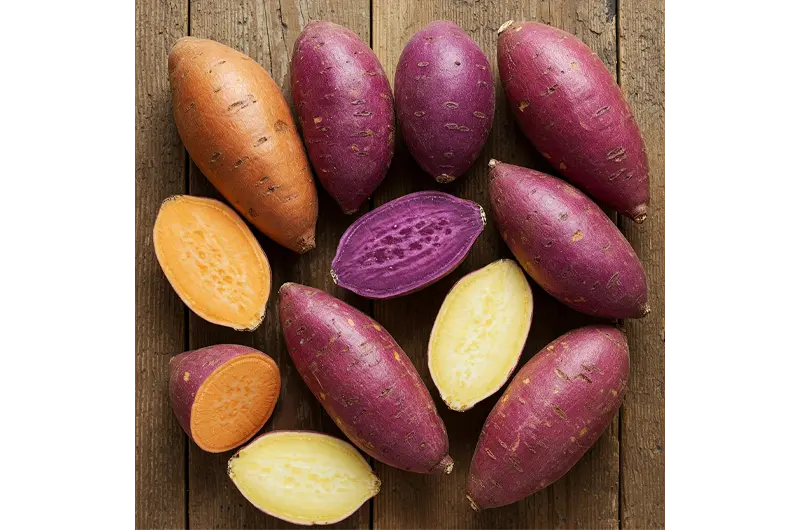
Where Do Sweet Potatoes Thrive? Climate Considerations
Sweet potatoes are fundamentally warm-weather crops.
Sweet Potatoes in Tropical and Subtropical Zones
- These climates are ideal. Sweet potatoes need long, hot summers with consistent moisture and warmth. They are highly sensitive to frost. A growing season of at least 4-5 months with temperatures consistently above 20°C (68°F) is preferred.
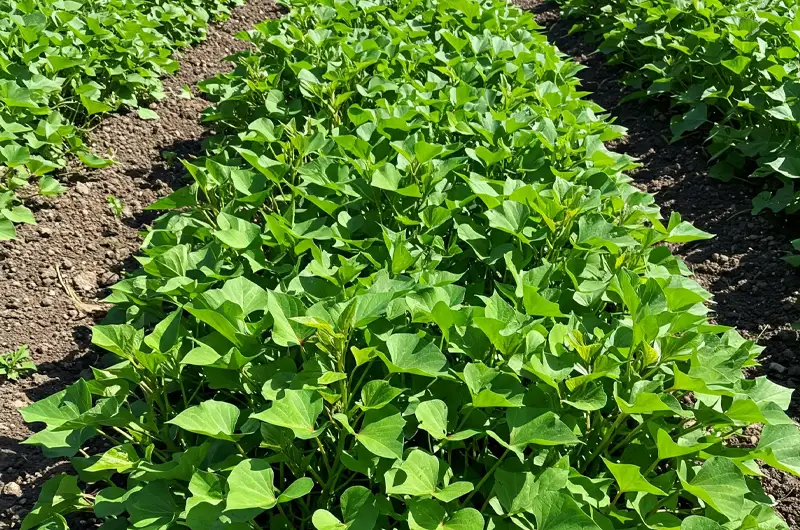
Growing Sweet Potatoes in Temperate Climates
- It’s possible to grow sweet potatoes in temperate regions, but success depends on selecting faster-maturing varieties and planting only after all danger of frost has passed and the soil has warmed significantly (at least 18°C or 65°F). Using black plastic mulch can help raise soil temperature.
Challenges in Cold Climates
- Growing sweet potatoes in cold climates with short summers is very challenging. The required long, warm growing season is usually absent. Growing might only be feasible in greenhouses or with significant season extension techniques, and yields may be low.
Sweet Potatoes Around the World
Sweet potatoes are a globally important food crop, valued for their nutrition, adaptability, and high yields.
- Asia: China is by far the world’s largest producer, where sweet potatoes are used for food, animal feed, and industrial purposes. They are also significant crops in countries like Indonesia, Vietnam, and India.
- Africa: They are a vital staple food in many parts of Sub-Saharan Africa, including Uganda, Nigeria, and Tanzania, prized for their role in food security due to their hardiness.
- The Americas: Widely grown and consumed in North, Central, and South America, from traditional dishes in Peru (their likely origin) to Thanksgiving tables in the USA.
- Oceania: A traditional staple in many Pacific Islands, including Papua New Guinea.
How to Grow Sweet Potatoes: Planting Guide
Sweet potatoes aren’t grown from seeds like many vegetables, nor from tubers like regular potatoes. They are grown from “slips.”
What are Sweet Potato Slips?
- Slips are rooted sprouts that grow from a mature sweet potato. You can buy certified disease-free slips from nurseries or grow your own by suspending a sweet potato partially in water or placing it on moist soil.
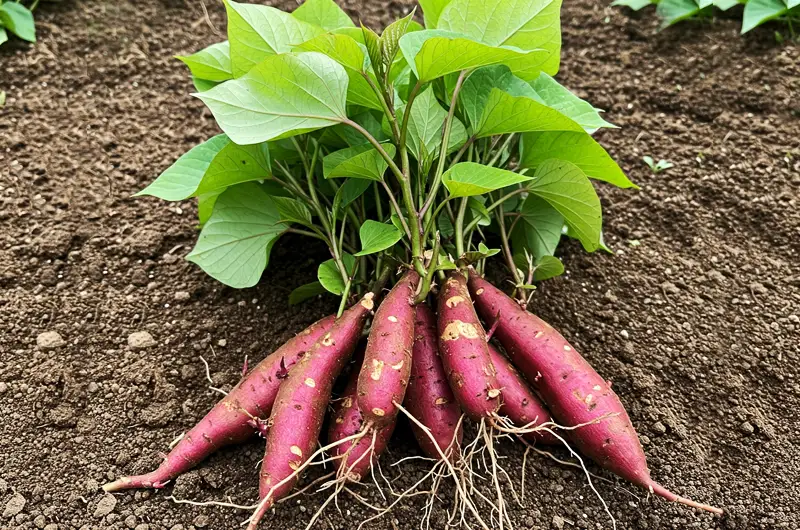
Preparing the Soil
- Sweet potatoes prefer loose, well-drained, sandy loam soil. Avoid heavy clay or overly rich soil (which encourages vine growth over root development). A slightly acidic pH (5.5-6.5) is ideal. Choose a location with full sun (at least 6-8 hours daily). Raised beds or mounds work well, improving drainage and soil warmth.
Planting the Slips
- Plant slips after the last frost when the soil is warm. Create ridges or mounds about 15-20 cm (6-8 inches) high. Plant the slips about 30-45 cm (12-18 inches) apart, burying the roots and the stem up to the first few leaves. Water thoroughly after planting.
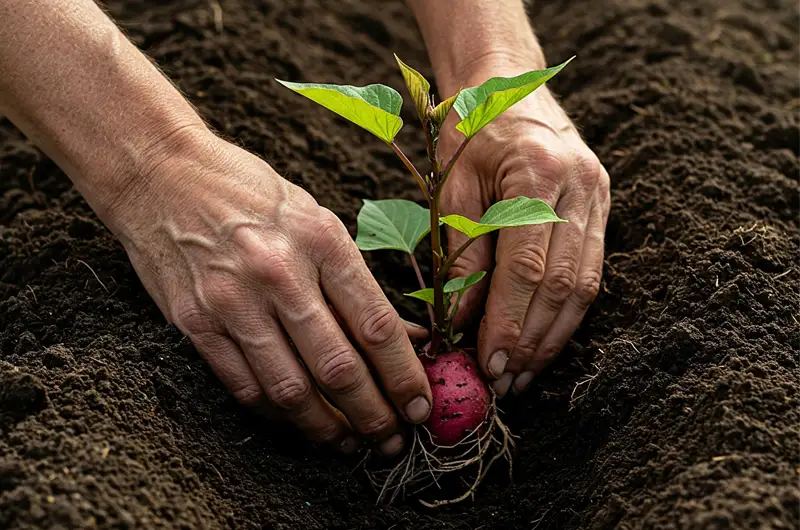
Caring for Your Sweet Potato Plants
Sweet potatoes are relatively low-maintenance once established.
Watering Needs
- Keep the soil consistently moist, especially during the first few weeks after planting and during root development. Water deeply once or twice a week, depending on rainfall and heat. Reduce watering in the last 3-4 weeks before harvest to prevent roots from splitting.
Weeding and Mulching
- Keep the area weed-free, particularly when plants are young. Once the vines spread, they act as a natural groundcover, suppressing weeds. Mulching can help retain moisture and control weeds.
Pests and Diseases
Common pests include the sweet potato weevil (especially in warmer climates), wireworms, and flea beetles. Fungal diseases like scurf or black rot can occur, often due to poor drainage or infected slips. Crop rotation and using certified slips help prevent issues. Deer and rabbits can also be attracted to the foliage.
Harvesting Your Sweet Potatoes
- Sweet potatoes are typically ready to harvest 90-120 days after planting, depending on the variety and climate. Look for yellowing leaves as a sign of maturity. Harvest before the first fall frost, as cold temperatures can damage the roots. Dig carefully around the plant with a spading fork, lifting the roots gently to avoid bruising.
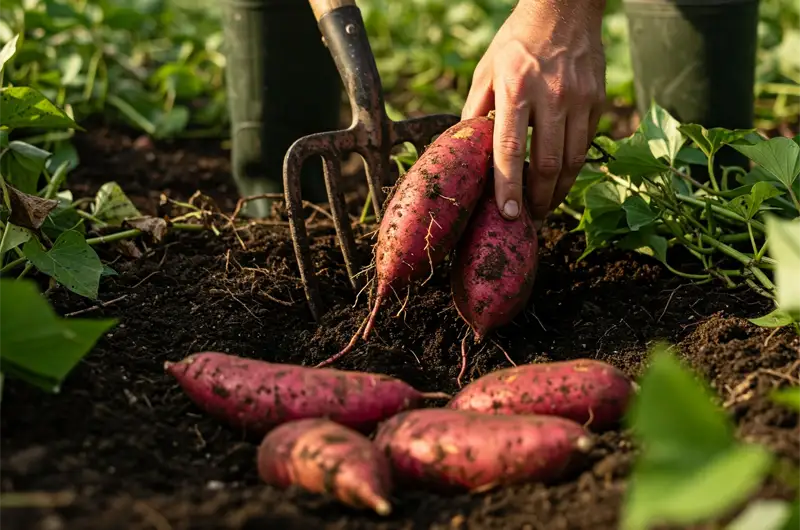
Curing and Storing Sweet Potatoes
Proper curing is essential for flavour development and long-term storage. Let the harvested roots air dry for a few hours, then cure them in a warm, humid place (around 27-29°C or 80-85°F with 85-90% humidity) for 1-2 weeks. After curing, store them in a cool, dry, dark place (around 13-15°C or 55-60°F). Do not refrigerate raw sweet potatoes, as this damages their quality and flavour.
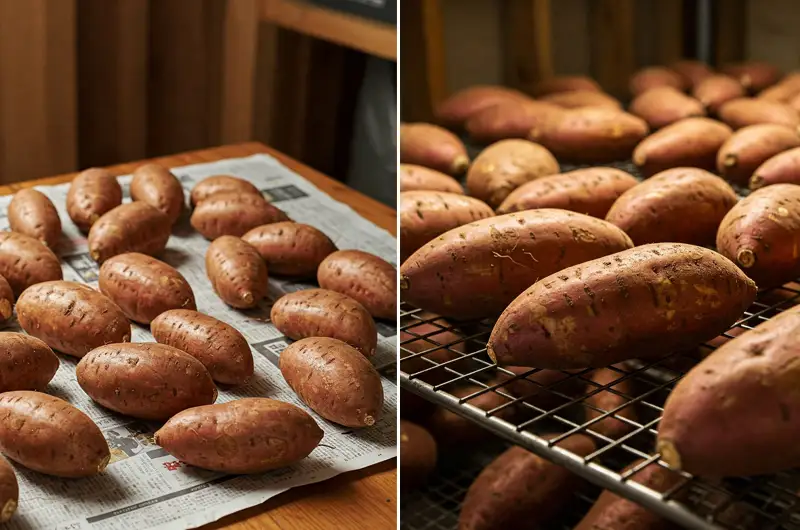
The Enduring Appeal of the Sweet Potato
From its ancient roots to its place on modern tables worldwide, the sweet potato (Ipomoea batatas) is a remarkable plant. Understanding all about sweet potatoes – their diverse types, preferred climates, and how to grow and care for them – highlights their importance as a resilient and nutritious food source. Whether you grow them yourself or simply enjoy eating them, sweet potatoes offer a wealth of flavour and nutrition.
Read More about Sweet Potato:
- Sweet Potato Benefits: A Guide to Nutrition, Health, and Uses
- Sweet Potato Leaves Benefits: The Edible Green Powerhouse
Latest Posts:

